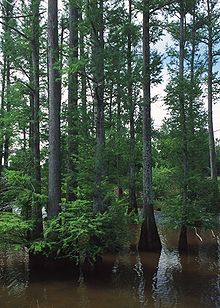| Taxodium distichum | |
|---|---|

| |
| Bald cypress forest in a central Mississippi lake | |
| Scientific classification | |
| Kingdom: | Plantae |
| Clade: | Tracheophytes |
| Clade: | Gymnospermae |
| Division: | Pinophyta |
| Class: | Pinopsida |
| Order: | Cupressales |
| Family: | Cupressaceae |
| Genus: | Taxodium |
| Species: | T. distichum
|
| Binomial name | |
| Taxodium distichum | |

| |
Taxodium distichum (baldcypress,[3][4][5] bald-cypress,[6] bald cypress, swamp cypress; French: cyprès chauve; cipre in Louisiana) is a deciduous conifer in the family Cupressaceae. It is native to the southeastern United States. Hardy and tough, this tree adapts to a wide range of soil types, whether wet, salty, dry, or swampy. It is noted for the russet-red fall color of its lacy needles.
This plant has some cultivated varieties[7][8][9][10][11] and is often used in groupings in public spaces. Common names include bald cypress, swamp cypress, white cypress, tidewater red cypress, gulf cypress and red cypress.[12][13]
The bald cypress was designated the official state tree of Louisiana in 1963.[14]
In some cultures, the bald cypress symbolizes longevity, endurance, and mourning.[citation needed]
Bald cypress trees are valued because of their rot-resistant heartwood when the trees are mature. Because of this, the trees are often used for making fence posts, doors, flooring, caskets, and a number of other items.
- ^ Farjon, A. (2013). "Taxodium distichum". IUCN Red List of Threatened Species. 2013: e.T42261A2967873. doi:10.2305/IUCN.UK.2013-1.RLTS.T42261A2967873.en. Retrieved 19 November 2021.
- ^ "NatureServe Explorer". Retrieved 17 May 2021.
- ^ "LC Subject Headings: Baldcypress". Library of Congress. Retrieved 28 September 2024.
- ^ Wilhite, L.P.; Toliver, J.R. (1990). "Taxodium distichum (L.) Rich. Baldcypress". In Burns, Russell M.; Honkala, Barbara H. (eds.). Silvics of North America. Vol. 1: Conifers. Washington, D.C.: Forest Service, U.S. Department of Agriculture. pp. 563–572. Agriculture Handbook 654. Retrieved 28 September 2024.
- ^ Gilbert, Edward F.; Watson, Dennis G.; Klein, Ryan W.; Koeser, Andrew K.; Hilbert, Deborah R.; McLean, Drew C. (29 March 2019). Andreu, Michael; Klein, Ryan; Hilbert, Deborah R. (eds.). "Taxodium distichum: Baldcypress". Southern Trees Fact Sheets. IFAS Extension, University of Florida. Publication No. ENH-778. Retrieved 28 September 2024.
- ^ Watson, Frank D. (1993). "Taxodium distichum var. distichum". In Flora of North America Editorial Committee (ed.). Flora of North America North of Mexico (FNA). Vol. 2. New York and Oxford: Oxford University Press. Retrieved 28 September 2024 – via eFloras.org, Missouri Botanical Garden, St. Louis, MO & Harvard University Herbaria, Cambridge, MA.
- ^ USDA, NRCS (n.d.). "Taxodium distichum". The PLANTS Database (plants.usda.gov). Greensboro, North Carolina: National Plant Data Team. Retrieved 8 December 2015.
- ^ Farjon, A. (2005). Monograph of Cupressaceae and Sciadopitys. Royal Botanic Gardens, Kew. ISBN 1-84246-068-4
- ^ Watson, Frank D. (1993). "Taxodium distichum". In Flora of North America Editorial Committee (ed.). Flora of North America North of Mexico (FNA). Vol. 2. New York and Oxford: Oxford University Press – via eFloras.org, Missouri Botanical Garden, St. Louis, MO & Harvard University Herbaria, Cambridge, MA.
- ^ Earle, Christopher J., ed. (2018). "Taxodium distichum subsp. distichum". The Gymnosperm Database.
- ^ Wilhite, L. P.; Toliver, J. R. (1990). "Taxodium distichum". In Burns, Russell M.; Honkala, Barbara H. (eds.). Conifers. Silvics of North America. Vol. 1. Washington, D.C.: United States Forest Service (USFS), United States Department of Agriculture (USDA) – via Southern Research Station.
- ^ "Bald-cypress | The Morton Arboretum". www.mortonarb.org. Retrieved 14 January 2019.
- ^ "Baldcypress Tree on the Tree Guide at arborday.org". www.arborday.org. Retrieved 15 January 2019.
- ^ Calhoun, Milburn; Frois, Jeanne (31 May 2006). Louisiana Almanac, 2006-2007 (17th ed.). Pelican Publishing. p. 431. ISBN 978-1-58980-307-7.

